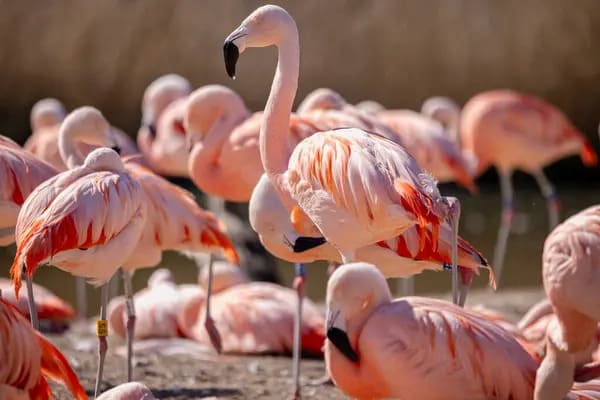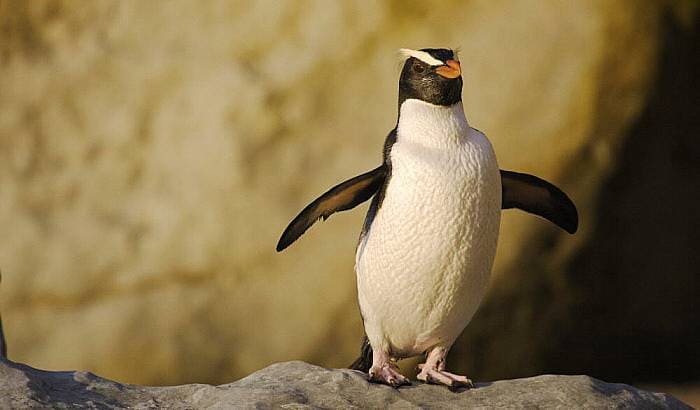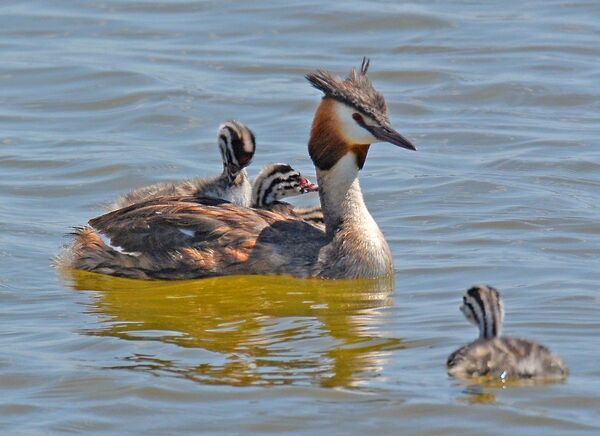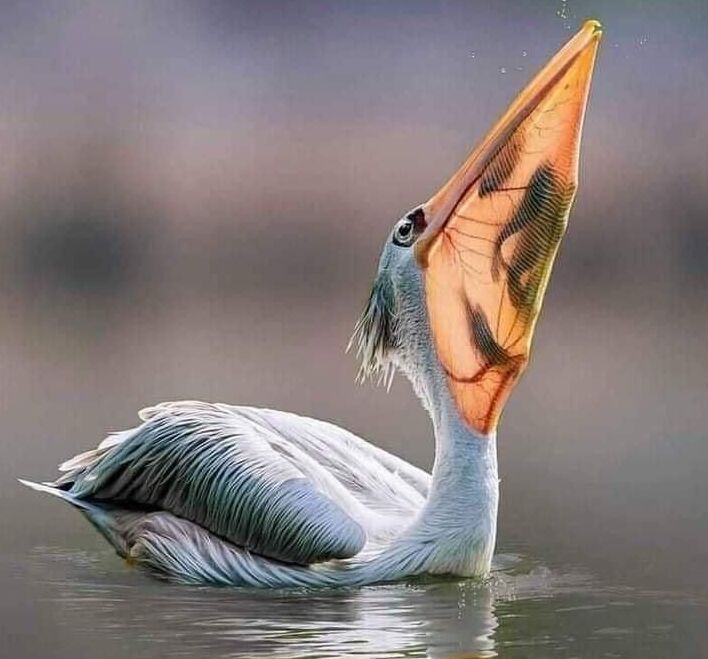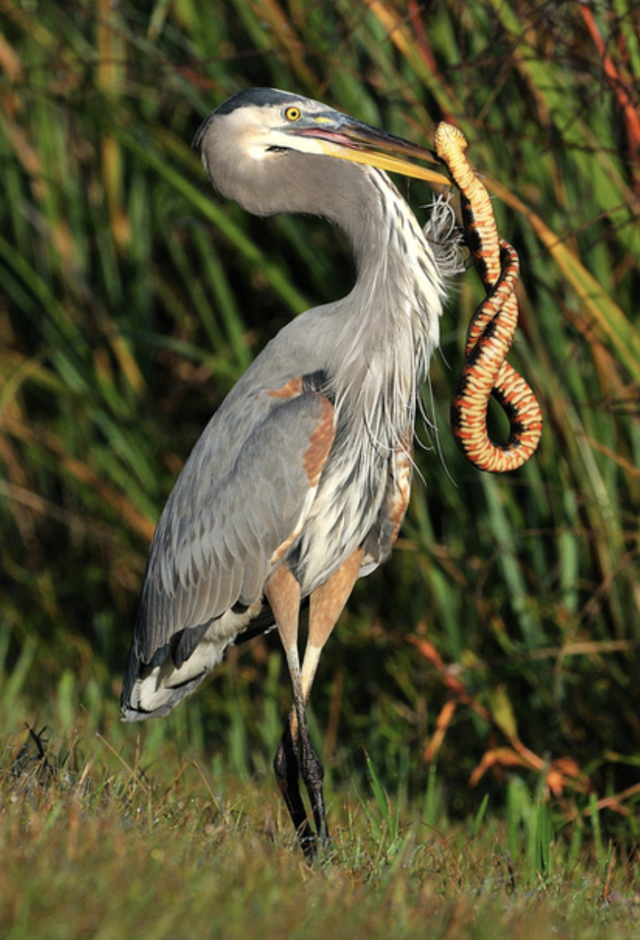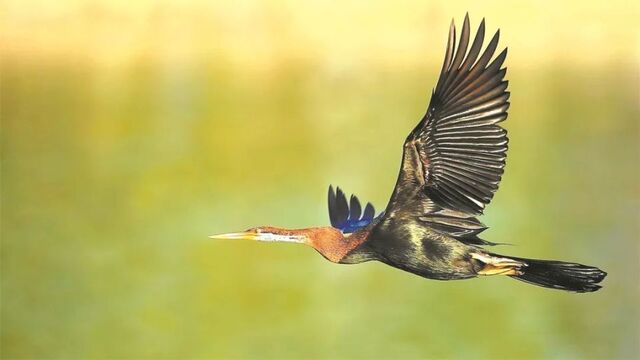Phoenicopterus roseus
IUCN
LCBasic Information
Scientific classification
- name:Phoenicopterus roseus
- Scientific Name:Phoenicopterus roseus,
- Outline:Wading birds
- Family:
Vital signs
- length:130-142cm
- Weight:2.5-3.5kg
- lifetime:20-50years
Feature
It is similar in size to a stork, with a short, thick beak, a slender neck that curves into an "S" shape, and extremely long legs.
Distribution and Habitat
It mainly inhabits wide, shallow areas that are rarely visited by humans, shallow areas of saltwater lakes and freshwater habitats, swamps and lagoons, such as lagoons, estuaries, mudflats and coastal or inland lakes, which are usually only a few centimeters deep and have rich algae. It mainly feeds on algae and plankton in silt or shallow water.
Appearance
The Greater Red Flamingo is similar in size to a stork, with a short and thick beak. The middle of the upper beak is protruding and curved downward, and the lower beak is larger and groove-shaped. The front of the beak is black, the middle is light red, and the base is yellow. The neck is long and curved, and the slender neck is bent in an "S" shape. It has a pair of thin and long red legs. The legs are extremely long and bare. There are steps between the three forward toes, and the hind toes are short and do not touch the ground. The wingspan is more than 150 cm, the wings are moderate in size, the wings are reddish, but the tail feathers are very short, the body feathers are white with rose color, the flight feathers are black, and the coverts are dark red. Males and females are similar. It is a large wading bird with bright and colorful feathers. The feathers on its body are mainly scarlet.
Details
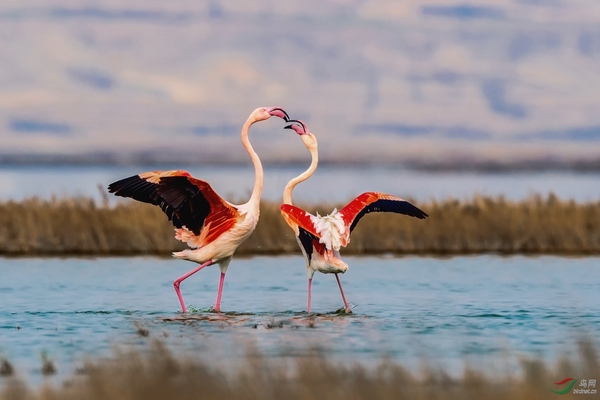
The Greater Flamingo is a genus of Flamingo in the order Phoenicopteridae, class Aves, phylum Chordata, with 1 genus and 6 species: about 80-160 cm tall, 130-142 cm long, and 2.5-3.5 kg in weight. It is a "lost bird" and is very rare. The Greater Flamingo has a high ornamental value, a gentle temperament, timidity and alertness, and is a popular ornamental bird in the zoo. It has been included in the list of terrestrial wild animals that are beneficial or have important economic and scientific research value under national protection.
Also known as the Greater Flamingo, Red Flamingo, Flamingo, etc., male and female are similar, and male flamingos are slightly larger than females. The Greater Flamingo is similar in size to a stork, with a short and thick beak, the middle of the upper beak protruding downward, and the lower beak is larger and groove-shaped. The front end of the beak is black, the middle is light red, and the base is yellow. The neck is long and curved, and the slender neck is bent in an "S" shape. There is a pair of thin and long red legs. The legs are extremely long and bare, with a tread between the three forward toes, and the hind toes are short and do not touch the ground. The wingspan is more than 150 cm, the wings are moderate in size, the wings are reddish, but the tail feathers are very short, the body feathers are white with a rose color, the flight feathers are black, and the coverts are dark red. Males and females are similar. It is a large wading bird with bright and colorful feathers. The feathers on the whole body are mainly scarlet, especially the feathers at the base of the wings, which are shiny and glossy. From a distance, it looks like a burning fire, hence the name flamingo.
The red color is not the original color of the flamingo's feathers, but comes from the plankton it ingests (according to Professor Francisco Buda, a scientist at Leiden University in the Netherlands, and his experimental team members in 2008, through precise quantum computing methods, they found that the reason why flamingos, salmon, shrimps, crabs, etc. are attractive and bright red is because flamingos, salmon, shrimps, crabs, etc. are rich in Astaxanthin, abbreviated as ASTA in Chinese, and animals cannot synthesize ASTA. Most shrimps and crabs obtain ASTA by eating algae and plankton and other plants). The flamingo mainly eats algae, protozoa, small worms, and insect larvae in the water, and occasionally eats small mollusks and crustaceans. The way of eating is unique and very wonderful. First, bend the long neck down, turn the head over, and then walk while sweeping the curved beak to the left and right to touch the bottom of the water to feed. Due to the special structure of the beak, the groove of the lower beak is deep, and the upper beak is shallow and lid-shaped. There are sparse serrations and fine hairs on the edge. When it is inverted in the water, it is like a large sieve, which can quickly suck in and filter out water and keep food in the mouth. In addition, its tongue is large, which can also help to press out water and prevent swallowing large objects. By eating shrimp, small fish, algae, plankton, etc. to transmit ASTA, the originally white feathers are transmitted with bright red. At the same time, the brighter the red, the stronger the flamingo's physique, the more attractive it is to flamingos of the opposite sex, and the better the offspring it reproduces.
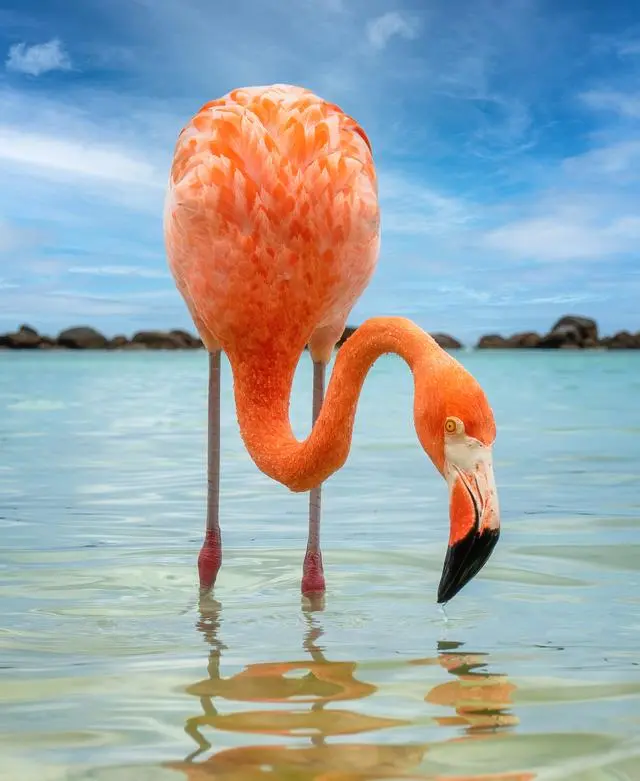
The greater red flamingo lives and feeds in pairs. It mainly inhabits wide shallow water areas where few people go, shallow water areas of salt lakes, swamps and lagoons, usually only a few centimeters deep, with rich algae growing in the water. It mainly feeds on algae and plankton in silt or shallow water.
Flamingos also migrate, especially those living in Central America. At the end of each year, they come to the Florida Peninsula in the southern United States, which is surrounded by water on three sides, to spend some time. There is a world-famous Hiari Racecourse near Miami, Florida, where winter horse racing is held at the same time as the arrival of flamingos. At this time, the racecourse is always crowded and lively. Even bars, restaurants, shops, and hotels are named after flamingos. Red flags symbolizing flamingos are flying everywhere. Staff drive red cars to bring a group of flamingos from the island to the racecourse, forming a fiery world. The tourists who gather here also like to send nearly one million postcards with photos or patterns of flamingos to all parts of the world from here, which makes most people feel that "this place is the hometown of flamingos".
The flamingo likes to live in groups, often tens of thousands, even up to 100,000 or more, gathered together, closely arranged one by one, with calls similar to those of geese one after another, deafening. From a distance, the red legs are like a forest, like spiders, and the long necks are frequently wriggling alternately, which is very spectacular. If you look down from a plane, the ground is red, stretching for several kilometers, like a huge red carpet, and like a boiling red wave in a swampy wilderness. The scene is full of vitality and refreshing.
The flamingo has a gentle temperament, usually appears timid and alert, and has excellent swimming skills. When flying, it can stretch its neck and legs in a straight line, and as long as one flies into the sky, there will be a large group of them following closely, flying and calling, like a red ribbon passing through the blue sky and white clouds.
The greater red flamingo is distributed in western Asia, northern Africa, the Atlantic coast of America and southern Europe. It is found in Xinjiang, Qinghai, Yunnan, Hubei, etc. in China, Afghanistan, Angola, Armenia, Azerbaijan, Bahrain, Bangladesh, Botswana, Burundi, Angkor, Cape Verde, Comoros, Cyprus, Djibouti, Egypt, Eritrea, Ethiopia, France, Gambia, Gibraltar, Greece, Guinea, Guinea-Bissau, India, Islamic Republic of Iran, Iraq, Israel, Italy, Jordan, Kazakhstan, Kenya, Kuwait, Lebanon, Libya, Macedonia, Madagascar, Malawi, Maldives, Mauritania, Mayotte, Morocco, Mozambique, Namibia, Nepal, Oman, Pakistan, Palestine, Portugal, Qatar, Russian Federation, Sao Tome and Principe, Saudi Arabia, Senegal, Seychelles, Sierra Leone, Slovenia, Somalia, South Africa, Spain (Canary Islands - Migrant bird), Sri Lanka, Sudan, Syrian Arab Republic, United Republic of Tanzania, Tunisia, Turkey, Turkmenistan, Uganda, United Arab Emirates, Uzbekistan, Western Sahara, Yemen, Zambia, Zimbabwe.
Migrant bird: Austria, Belarus, Belgium, Bulgaria, Cameroon, China, Cocos Islands, Democratic Republic of Congo, Croatia, Czech Republic, Denmark, Equatorial Guinea, Finland, Germany, Hungary, Kyrgyzstan, Latvia, Lesotho, Malta, Mauritius, Mongolia, Montenegro, Niger, Norway, Poland, Reunion, Romania, Serbia, Slovakia, Swaziland, Sweden, Switzerland, Tajikistan.
Wandering bird: The nominate subspecies (roseus) has records of flocks and individual birds in northwest China, and one bird has been recorded in Dongting Lake, which may have separated from the breeding group in Afghanistan or central Kazakhstan and entered China.
Evidence shows that the ancestors of flamingos began to differentiate as early as the Miocene 30 million years ago, much earlier than most other birds. Fossils discovered in 1976 suggest that their ancestors were shore birds similar to plover. Fossilized footprints of flamingos dating back about seven million years have been found in the Andes Mountains.
The world's oldest flamingo, 83 years old, died at the Adelaide Zoo in Australia on January 30, 2013.
It was already an adult bird when it arrived in Australia in 1933. The oldest Greater Flamingo was in Australia and lived for at least 75 years, but its true age is unknown.
In December 2012, Sichuan recorded the first Greater Flamingo in the wild.
In November 2013, Qinghai discovered the first Greater Flamingo in the wild.
In 2016, the world's rare bird Greater Flamingo was discovered in the Lianyungang Wetland in Jiangsu.
The reproduction of the flamingo is also group-based, with hundreds or thousands of birds gathering together to form a courtship group, but the marriage is mainly "monogamous". During mating, the male bird jumps onto the female bird, and only then can their genders be clearly distinguished. They build nests once a year, but most new nests are built on top of old nests. The nest is above the water surface, and is generally built on a peninsula-shaped mound or mudflat surrounded by water on three sides. Sometimes, an "island" is built in the water with weeds. When building the nest, the beak is used to roll the wet mud into a small ball, and then some fibrous materials such as grass stems are mixed in. Then, the feet are used to build a "bunker"-style nest with a small top and a large bottom and a groove on the top. The height is 12.7-45.7 cm and the diameter is 38-76 cm. It is unique, sturdy and durable, and will not collapse even if it is washed by heavy rain. The nests of each group are often arranged neatly, forming a very orderly "small village". The distance between the nests is about 60 cm. There are many small grooves dug inside to communicate with the water surface, so that they can enter the water at any time to forage, stand in shallow water to look out, or dive into the water to swim during the incubation period.
During the nesting period, the temperament sometimes becomes fierce and aggressive, and some small conflicts occur from time to time due to fighting for "territory" or robbing nest materials. There are also some impatient individuals who rush into the nest to lay eggs and hatch without waiting for the mud to dry. Its eggs are pale white, and they breed from June to July every year, with only 1-2 eggs per nest. The incubation work is shared by the male and female birds. When one is hatching, the other guards the side of the nest. The incubation period is about 28-32 days. After hatching, the chicks can walk on the ground as soon as their feathers dry. They can swim in the water the next day. After 4-5 days, they are very active, but they mainly rely on the milk secreted in the crop of the adult bird to survive.
The chicks' down feathers are gray and silky, their legs are also gray, and their beaks are not curved but straight. At two and a half months old, the chicks can learn to fly. After a year, their body shape is almost the same as that of the adult birds, but their body color is still gray. It will not turn red until the third year, reaching sexual maturity. The lifespan is about 20-50 years.
Subspecies differentiation
Single species, no subspecies differentiation.
Note: Species classification once divided the greater flamingo into two subspecies: the American subspecies of the greater flamingo (Phoenicopterus roseus ruber) and the nominate subspecies of the greater flamingo (Phoenicopterus roseus roseus). It was not until 2012 that the World Conservation Union (IUCN) divided it into two independent species, namely the Greater Flamingo (Phoenicopterus roseus) and the Caribbean Flamingo (Phoenicopterus ruber).
Listed in Appendix I, II and III of the Convention on International Trade in Endangered Species of Wild Fauna and Flora (CITES) 2019 Edition Appendix II.
Listed in the IUCN Red List of Threatened Species in 2018 ver 3.1 - Least Concern (LC).
This species has been included in the List of Terrestrial Wildlife with Important Economic and Scientific Research Value under State Protection (Item 37) issued by the State Forestry Administration of China on August 1, 2000.
This species has a wide distribution range and is not close to the vulnerable and endangered critical value standard for species survival (distribution area or fluctuation range less than 20,000 square kilometers, habitat quality, population size, and fragmented distribution area). The population trend is stable, so it is evaluated as a species without survival crisis.

